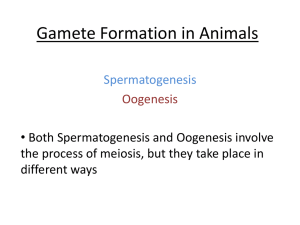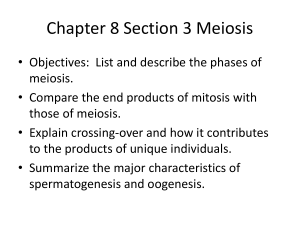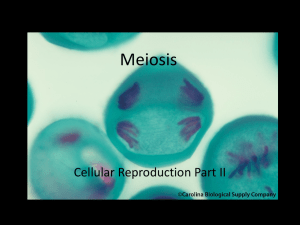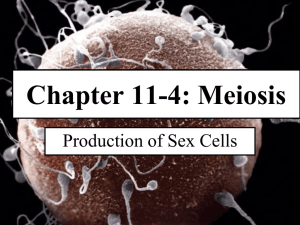Meiosis
advertisement
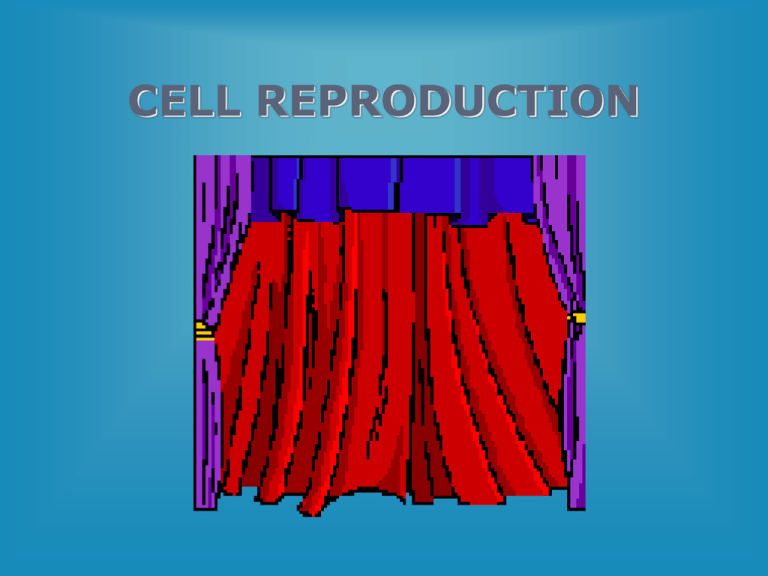
CELL REPRODUCTION MEIOSIS Lesson Objectives –Meiosis • Describe asexual reproduction; explain the genetic relationship between parent and offspring. • Describe sexual reproduction; explain the genetic relationship between parent and offspring. • Describe gametogenesis and identify the key differences between oogenesis and spermatogenesis. • Identify and describe the main steps of meiosis, distinguishing between the quantity of genetic material in the parent and resulting cells. ASEXUAL REPRODUCTION • • • • One parent Offspring genetically identical to parent Does not happen through MEIOSIS!!! Some modes of reproduction: – Binary fission – Budding – Spore formation SEXUAL REPRODUCTION • Two parents • Offspring NOT genetically identical to parents • Happens through MEIOSIS.. SEXUAL REPRODUCTION AND GAMETES • Two different cells join together to form a new organism • Gametes (sexual reproduction cells) only have one-half of the chromosomes found in body cells • Two types of gametes – Sperm (male) – Eggs or ova (female) • The union of these two is called fertilization • New diploid cell formed from two haploid cells is called a zygote • Number of chromosomes present in each gamete called haploid number (n) • Number of chromosomes present in each body cell called diploid number (2n) GAMETOGENEIS: SPERMATOGENESIS AND OOGENESIS • Spermatogenesis produces four haploid sperm cells • Oogenesis produces one mature ovum or egg cell CROSSING_OVER Formation of homologous chromosomes called a tetrad http://youtu.be/CCqAri4wtjQ BACK MEIOSIS • Form of cell division that produces daughter cells having half the number of chromosomes of the parent cell • Phases of meiosis similar to mitosis – Mitosis produces two genetically identical diploid cells from one diploid cell • Four phases • Cell divides once – Meiosis creates four genetically different haploid cells from one diploid cell • Eight phases • Cell divides twice PHASES OF MEIOSIS • Meiosis I 1. Prophase I 2. Metaphase I 3. Anaphase I 4. Telophase I and Cytokinesis I • Meiosis II 5. Prophase II 6. Metaphase II 7. Anaphase II 8. Telophase II and Cytokinesis II MEIOSIS I • Prophase I crossing-over occurs (genetic variation) NEXT • Metaphase I independent assortment VIEW • Anaphase I homologous chromosomes separated • Telophase I & Cytokinesis I two daughter cells formed CONTINUE INDEPENDENT ASSORTMENT RETURN MEIOSIS II • • • • Prophase II Metaphase II Anaphase II Telophase II & Cytokinesis II Note: DNA is not replicated again between Meiosis I and Meiosis II Summary: At the end of meiosis, 4 daughter cells are formed = eggs or sperm. Each contains half as many chromosomes as the parent cell (n); each cell is genetically different from its parents and from its "siblings". Fertilization of an egg by a sperm restores the chromosome number to 2n. GENETIC VARIABILITY OF FOUR HAPLOID CELLS Lesson Summary—Meiosis • Asexual reproduction produces a clone, an organism that is genetically identical to its parent. • Asexual reproduction includes binary fission, budding, and spore formation. • Sexual reproduction involves haploid gametes and produces a diploid zygote through fertilization. • Meiosis is a type of cell division that halves the number of chromosomes. There are eight stages of meiosis, divided into meiosis I and meiosis II. DNA is not replicated between meiosis I and meiosis II. • Crossing-over, the independent assortment of chromosomes during anaphase I, and random fertilization result in genetic variation. • Meiosis is a step during spermatogenesis and oogenesis. Spermatogenesis produces four haploid sperm cells, while oogenesis produces one mature ovum. • Eukaryotes have three different versions of the sexual life cycle: a haploid life cycle, a diploid life cycle, and a life cycle known as the alternation of generations. The sexual life cycle depends on when meiosis occurs and the type of cell that undergoes meiosis.
